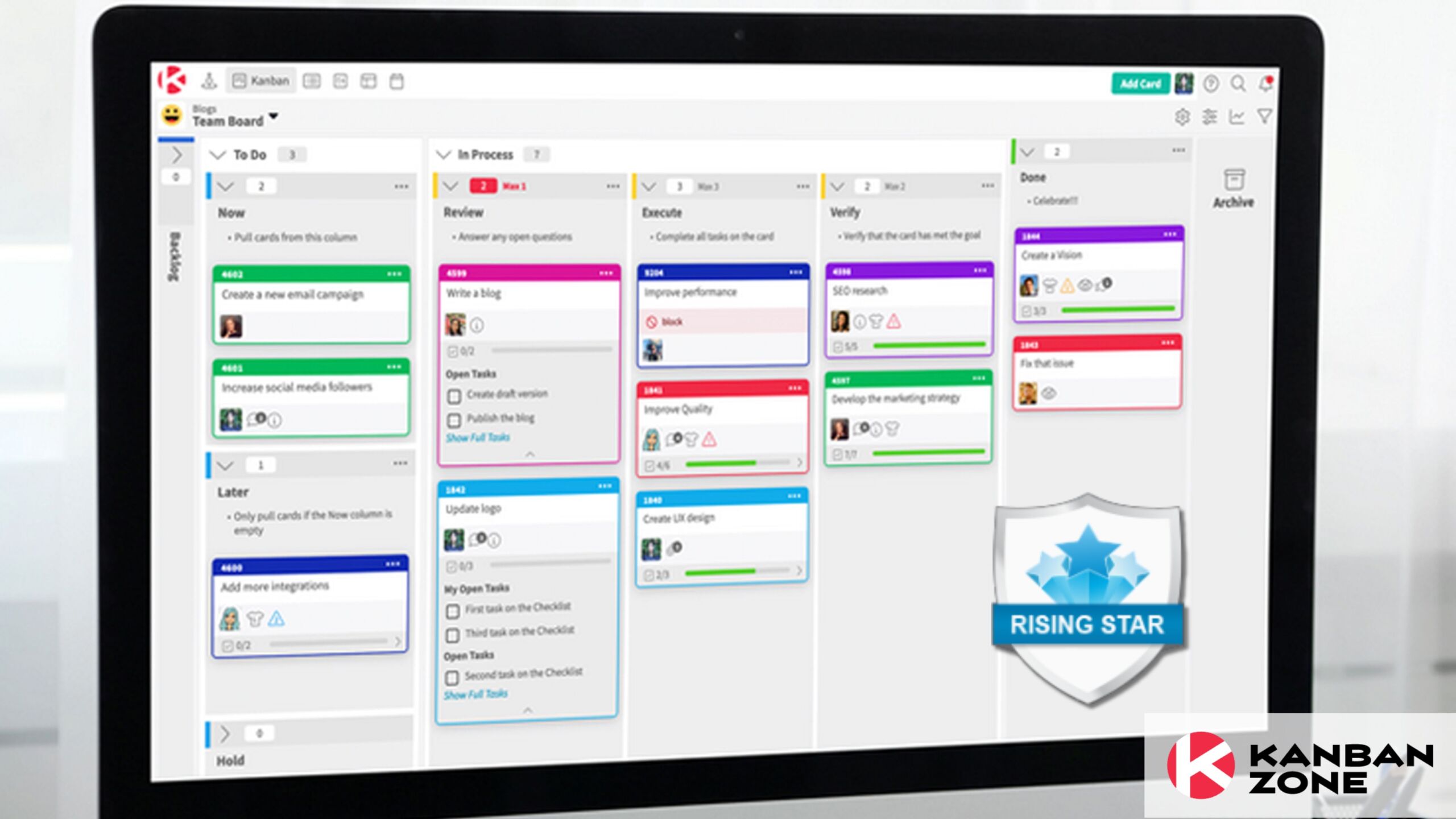
Do you know that effective project management is essential for any organization’s success in the fast-paced commercial climate of today? Small teams often face unique challenges when it comes to managing projects collaboratively.
The use of Kanban is one practical strategy that has grown in popularity recently. Small teams can improve cooperation, increase production, and optimize their workflows with the aid of the visual project management technique known as Kanban.
The essential steps to implementing Kanban into use for collaborative project management in small teams will be covered in this article.
What is Kanban?
Kanban is a versatile framework within the realm of Agile methodologies that focuses on enhancing workflow, ensuring flexibility in task management, and fostering continuous improvement.
It deviates from more drastic changes and instead emphasizes making small, meaningful alterations within existing setups. This approach is particularly appealing to traditional organizations that prioritize hierarchical structures and the roles of functional managers.
Benefits of Kanban for Collaborative Project Management
Implementing the Kanban methodology can yield several significant advantages for small teams, enhancing their efficiency, collaboration, and adaptability. Here are the benefits of using Kanban for small teams:
Implementing Kanban can offer significant benefits for small teams, including:
- Enhanced visibility into work processes
- Improved task prioritization and focus
- Increased adaptability to changing requirements
- Efficient resource utilization
- Better collaboration and communication
Setting Up Your Kanban Board for Project Management in Small Teams
Effective project management helps teams do well, especially small teams. They need simple and teamwork-focused ways to reach their goals. Kanban is a helpful method. It uses visuals to manage projects and is great for small teams who want to work together better and get things done faster. Here’s a breakdown of the process:
1. Selecting the Right Tools:
Choosing the right tools for your Kanban board is crucial for the successful implementation of collaborative project management in small teams. A Kanban project can be quickly created if you’re using kanbanzone.com. A “Kanban software development project” option must be chosen when setting up your project management in small teams.
This will automatically provide you with a Kanban board that reflects your team’s workflow.
2. Defining Work Stages and Columns:
Defining work stages and columns on your Kanban board helps visualize the flow of work from start to finish. By default, Kanban Zone provides a basic workflow with columns such as “Backlog,” “Selected for Development,” “In Progress,” and “Done.”
You can customize these columns to match your team’s specific workflow. For instance, you can add stages like “Review,” “Testing,” or “QA” if they’re relevant to your process. Customizing columns allows you to tailor the board to your team’s unique needs.
To configure your columns and workflow in Software:
- Click “Board” in the top-right corner of the backlog.
- Select “Configure.”
- Under “Columns,” you can add, remove, or edit columns to match your workflow stages.
- Once you’ve configured the columns, save the changes and go back to the board view.
3. Designing Your Kanban Board:
Crafting a Kanban board is essential for small-team project management. This visual aid streamlines workflow, enhances collaboration, and boosts productivity. Define columns for stages, arrange them logically, and set Work in Progress (WIP) limits to maintain focus.
Tailor columns to your project, add sub-columns for categorization, and use clear visual representations on task cards. Foster collaboration through comments and notes. Incorporate feedback loops for quality control.
Regularly evaluate and refine the board. A well-designed Kanban board empowers small teams to manage tasks effectively, promote teamwork, and achieve project success.
Limiting Work in Progress (WIP)
Limiting Work in Progress (WIP) is a fundamental practice in agile methodologies, including Kanban, that plays a crucial role in optimizing workflow, improving efficiency, and delivering value. This practice is particularly beneficial for effective project management in small teams. Let’s explore the different aspects of WIP limits:
- Importance of WIP Limits. Discuss the importance of limiting work-in-progress with the team. It helps reduce multitasking, prevents bottlenecks, and improves overall productivity.
- Setting WIP Limits. Work with the team to establish appropriate WIP limits for each workflow stage. These limits should be realistic and reflect the team’s capacity.
- Monitoring and Enforcing Limits. Regularly monitor the Kanban board to ensure that WIP limits are being adhered to. Before adding new work, the team must fix any columns that are beyond their capacity.
- Addressing Bottlenecks. If there are bottlenecks, the team should work together to find a solution. This could entail rearranging resources, offering support, or reviewing the workflow.
Collaboration and Communication
Effective collaboration and communication are crucial for the success of any project team. Here’s how to enhance these aspects:
1. Enhancing Team Communication:
Effective communication is the cornerstone of successful collaboration within a project team. Here’s how to enhance team communication:
Transparency: Foster transparency by sharing project objectives, progress, and relevant data with the entire team. Building trust through open communication keeps everyone on the same page.
Regular Updates: Ensure regular updates on project status, milestones, and any changes. This keeps everyone informed and reduces confusion.
Open Channels: Provide open communication channels for team members to ask questions, share ideas, and provide feedback. This encourages a culture of open dialogue.
Active Listening: Encourage active listening within the team. Ensure that team members feel heard and understood, promoting effective communication.
Clear Documentation: Document important discussions, decisions, and action items. This helps prevent misunderstandings and provides a reference for future discussions.
2. Regular Standup Meetings:
Regular standup meetings, often used in agile methodologies, enhance collaboration and communication among team members. Here’s how to conduct effective standup meetings:
Daily Updates: Conduct short daily standup meetings where team members share their progress, goals for the day, and any challenges they’re facing.
Time Bound: Keep standup meetings concise and time-bound to ensure they remain focused and efficient.
Remove Roadblocks: Standups provide an opportunity to identify and address roadblocks. Team members can collaborate to find solutions and offer assistance.
Remote Teams: For remote teams, use video conferencing tools to maintain face-to-face interactions and strengthen team bonds.
3. Addressing Challenges and Roadblocks:
Challenges and roadblocks are inevitable in any project. Addressing them promptly is essential for maintaining progress and team morale:
Proactive Approach: Encourage team members to proactively communicate the challenges they’re facing. This prevents issues from escalating.
Collaborative Problem-Solving: When challenges arise, involve the relevant stakeholders to collectively find solutions. Collaboration often leads to innovative problem-solving.
Regular Check-ins: Conduct regular check-ins with individual team members to discuss their progress and any obstacles. This personalized approach helps identify challenges early.
Resource Allocation: Address resource constraints promptly. If a team member requires additional resources or support, ensure they receive it on time.
Measuring and Analyzing
Measuring and analyzing project data is crucial for understanding workflow efficiency and identifying areas for improvement, especially in the context of collaborative project management in small teams.
Here’s how you can achieve this using data metrics, cumulative flow diagrams, cycle time, and throughput:
1. Collecting Data and Metrics:
Collecting data and metrics provides insights into your team’s performance, allowing you to make informed decisions. Key metrics include:
Regular Updates: Encourage team members to regularly update the Kanban board as tasks progress. This ensures that everyone is aware of the current status of the project.
Daily Stand-Up Meetings: Conduct daily stand-up meetings where team members share updates on their tasks, discuss any challenges, and coordinate efforts.
Visualizing Flow: Utilize tools like cumulative flow diagrams or control charts to visually represent the flow of work over time. These visuals provide insights into the efficiency of the process.
Throughput: Throughput refers to the amount of work your team completes within a specific period. It indicates your team’s capacity and productivity.
Code Signing Certificate: Consider security in your development process by implementing a code signing certificate. This certificate digitally signs and authenticates your team’s code, ensuring its origin and integrity. This is vital for software distribution, building user trust, and reducing the risk of tampering or malware injection. Incorporating a code signing certificate into your metrics enhances your software development lifecycle’s security
Scaling Kanban for Small Teams
While Kanban is naturally suited for small teams, it can also be scaled to manage larger projects or multiple teams:
- Challenges of Scaling. Understand the challenges that may arise when scaling Kanban, such as increased complexity, coordination, and communication.
- Strategies for Scaling. Implement strategies like breaking down work into smaller tasks, coordinating across teams, and establishing clear communication channels.
- Maintaining Agility. Despite scaling, prioritize maintaining the agile and flexible nature of the Kanban methodology. Avoid overcomplicating the process and focus on adaptability.
Conclusion
In summary, implementing Kanban for collaborative project management in small teams is a strategic move that enhances transparency, efficiency, and teamwork. Kanban’s focus on visualizing workflows, limiting work in progress, and promoting continuous improvement aligns well with the needs of dynamic small teams. This approach improves task tracking, reduces multitasking, and fosters open communication. By embracing Kanban’s principles, small teams can optimize their processes, allocate resources effectively, and cultivate a culture of adaptability and success. Kanban is more than a methodology; it’s a philosophy that empowers small teams to excel in their endeavors.
This was a guest blog. Please review our guest blog disclaimer.
Learn to Work Smarter, Not Harder!
Get our top articles weekly.
Table Of Contents
Discover many more posts…







